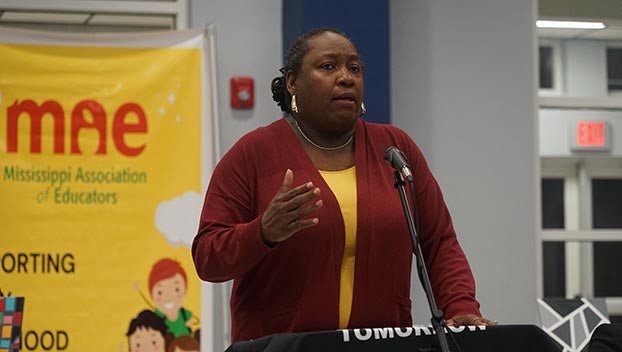Grade Inflation: NASD officials reviewing policies after statewide report cites district
Published 2:26 pm Monday, December 4, 2023

- NASD Superintendent Zandra McDonald-Green speaks at Natchez High School cafeteria. (File photo | The Natchez Democrat)
|
Getting your Trinity Audio player ready...
|
NATCHEZ — Natchez Adams School District Superintendent Zandra McDonald-Green said district leaders are aware of a Mississippi legislative committee citing excessive grade inflation and are taking steps to address the issue.
A Joint Legislative Committee on Performance Evaluation and Expenditure Review, better known as the PEER Committee, released the report on Thanksgiving week that evaluates 30 public school districts across the state and compares their grades in the classroom to annual state tests known as the Mississippi Academic Assessment Program.
PEER contracted with GlimpseK12, an education technology company based in Huntsville, Alabama, to comparatively review 30 public school districts on instruction in fiscal year 2022.
The report found that many schools in the state had students receiving high grades (A’s and B’s) but not scoring as proficient on the state tests.
NASD in particular showed the worst inflated grade percentage out of all 30 public school systems evaluated in eighth-grade math, with an inflation rate of 79%. Nearby Wilkinson County public showed the worst inflated grade percentage in fifth-grade math with an inflation rate of 89%.
NASD had the second highest percentage in fifth-grade math with an inflation rate of 70%, based on this report.
Green addressed this report during Tuesday’s school board meeting.
“We were aware of the report,” Green said. “Grade inflation is nothing new and something that we always have to address as educators. Over the last several years we’ve worked with our principals very diligently in looking at the type of assignments that students are given and what assignments are being graded to make certain that they are in line with the standards that are being taught.”
Green said principals are “putting eyes on” assignments on a week-by-week basis and determining if they match up to standards that are graded on state tests.
“That is something that we’ll continue to do,” she said. “We’ll continue to look at those grading practices.”
Green attributed the inflated grades in 5th and 8th-grade math to personnel challenges in those classrooms.
At the 8th-grade level, “when you have permanent subs in the classroom, that is something you just have to work on. This year we have the advantage of having certified instructors there,” she said. “Also with 5th-grade math we had two new, novice teachers and we’ll continue to evaluate our grading policies to make sure we’re able to decrease those numbers.”
School board member Diane Bunch questioned the accuracy of the report.
“Everybody in higher education understands that grade inflation is rampant because it’s the only thing that college students use for motivation,” Bunch said. “There are all kinds of studies out there that refute the way grade inflation is measured so I’m not sure that the study itself doesn’t have some flaws.”
Green also pointed out that the study compares nine weeks of instruction to a single standardized test, which can be flawed based on how individual students were feeling on testing day.
“I can be a straight A student and come in and test on one day not feeling well and not perform my best,” Green said. “So now you’re saying that my grade is inflated because on that one day, I didn’t feel well.”
Other districts with the worst percentage of inflated grades based on the report include Noxubee County, which had 88% for third-grade math, 74% for fourth-grade math, 65% for third-grade language arts, 69% for fourth-grade language arts, 76% for sixth-grade language arts and 74% for eighth-grade language arts; and Greenville with 74% for sixth-grade math.
The report also noted a mastery decline in one-third of the state’s students.
The report defines mastery decline as when a student scores lower on the year-end exam compared to one taken at the beginning of the school year, even if it is by one point.
Eighth graders exhibited the greatest decline at 52%.
PEER recommends that districts institute an internal review process to identify, track, and manage grade inflation. The committee also recommends that districts use software and other tools to track mastery decline to provide targeted help to struggling students.






